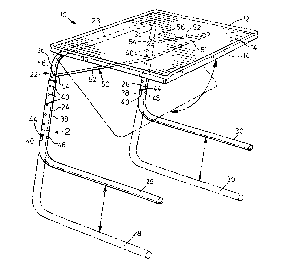Some of the information on this Web page has been provided by external sources. The Government of Canada is not responsible for the accuracy, reliability or currency of the information supplied by external sources. Users wishing to rely upon this information should consult directly with the source of the information. Content provided by external sources is not subject to official languages, privacy and accessibility requirements.
Any discrepancies in the text and image of the Claims and Abstract are due to differing posting times. Text of the Claims and Abstract are posted:
| (12) Patent: | (11) CA 2159924 |
|---|---|
| (54) English Title: | FOLDING TABLE |
| (54) French Title: | TABLE PLIANTE |
| Status: | Term Expired - Post Grant Beyond Limit |
| (51) International Patent Classification (IPC): |
|
|---|---|
| (72) Inventors : |
|
| (73) Owners : |
|
| (71) Applicants : |
|
| (74) Agent: | GOWLING WLG (CANADA) LLP |
| (74) Associate agent: | |
| (45) Issued: | 1999-02-09 |
| (22) Filed Date: | 1993-12-07 |
| (41) Open to Public Inspection: | 1995-04-16 |
| Examination requested: | 1997-12-16 |
| Availability of licence: | N/A |
| Dedicated to the Public: | N/A |
| (25) Language of filing: | English |
| Patent Cooperation Treaty (PCT): | No |
|---|
| (30) Application Priority Data: | ||||||
|---|---|---|---|---|---|---|
|
A folding table has a table top with an upper working surface and an
underside, the underside having at least one rearwardly located leg retainer and at
least one forwardly located strut retainer. A leg assembly has an elongated
connecting member and a pair of legs extending from opposite ends of the
connecting member, each leg having a foot member extending from a lower end
thereof remote from the connecting member. An angularly movable strut is
pivotally secured at the rear to at least one of the legs and is releasably engageable
at the front with the strut retainer. The strut is angularly movable between a
working position in releasable engagement with the strut retainer to maintain the
tabletop in a working position and a retracted position between the legs when
released from the strut retainer. The or each leg retainer retains the connecting
member in engagement therewith while permitting angular movement of the
table top between a working position and a folded position in which the table
top is substantially parallel to the legs.
Cette invention concerne une table pliante dont le plateau comporte du côté arrière de sa face inférieure au moins une fixation de piètement et de l'autre côté au moins une pièce d'appui d'étrésillon. Le piètement se compose d'un raccord allongé entre une paire de pieds qui se prolongent par une partie horizontale s'éloignant dudit raccord. Un étrésillon mobile autour d'axe horizontal prévu dans au moins un des pieds, qui sont situés du côté arrière de la table, se cale de façon amovible dans la pièce d'appui d'étrésillon prévue sur la moitié avant de la face inférieure du plateau. L'étrésillon pivote entre une position de travail où il est calé de façon amovible dans la pièce d'appui d'étrésillon pour maintenir le plateau à l'horizontale et une position escamotée entre les pieds de la table, une fois libéré de ladite pièce d'appui d'étrésillon. Le raccord susmentionné est monté dans la ou les fixations de piètement solidaire(s) du plateau de façon à constituer un axe autour duquel le plateau peut pivoter entre une position horizontale et une position escamotée où il est sensiblement parallèle aux pieds de la table.
Note: Claims are shown in the official language in which they were submitted.
Note: Descriptions are shown in the official language in which they were submitted.

2024-08-01:As part of the Next Generation Patents (NGP) transition, the Canadian Patents Database (CPD) now contains a more detailed Event History, which replicates the Event Log of our new back-office solution.
Please note that "Inactive:" events refers to events no longer in use in our new back-office solution.
For a clearer understanding of the status of the application/patent presented on this page, the site Disclaimer , as well as the definitions for Patent , Event History , Maintenance Fee and Payment History should be consulted.
| Description | Date |
|---|---|
| Inactive: Expired (new Act pat) | 2013-12-07 |
| Inactive: Office letter | 2008-11-12 |
| Inactive: Entity size changed | 2002-10-02 |
| Grant by Issuance | 1999-02-09 |
| Inactive: Final fee received | 1998-10-20 |
| Pre-grant | 1998-10-20 |
| Notice of Allowance is Issued | 1998-10-09 |
| Notice of Allowance is Issued | 1998-10-09 |
| Letter Sent | 1998-10-09 |
| Inactive: Approved for allowance (AFA) | 1998-10-01 |
| Inactive: RFE acknowledged - Prior art enquiry | 1998-03-18 |
| Inactive: Status info is complete as of Log entry date | 1998-03-18 |
| Inactive: Application prosecuted on TS as of Log entry date | 1998-03-18 |
| Request for Examination Requirements Determined Compliant | 1997-12-16 |
| All Requirements for Examination Determined Compliant | 1997-12-16 |
| Application Published (Open to Public Inspection) | 1995-04-16 |
There is no abandonment history.
The last payment was received on 1998-10-28
Note : If the full payment has not been received on or before the date indicated, a further fee may be required which may be one of the following
Please refer to the CIPO Patent Fees web page to see all current fee amounts.
Note: Records showing the ownership history in alphabetical order.
| Current Owners on Record |
|---|
| INO-PRODUCTS INC. |
| Past Owners on Record |
|---|
| DOUGLAS SOPER |